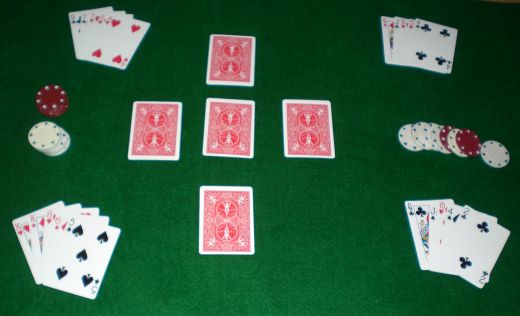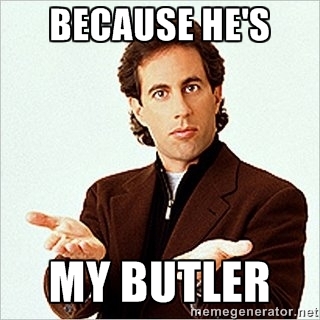after a few weeks of being too busy to play my regular tues/thurs night game i made my return tonight to find a new game added to the mix: criss cross.
the game proceeds as follows:
- each player is dealt four hole cards
- a betting round occurs beginning to the left of the button (there are no blinds or antes)
- each betting round is force bet; i.e., you must either bet, call, raise, or fold - no checking
- after the first betting round, the board is dealt - five cards in a cross pattern as pictured below - and one of the four outer cards is turned face up

- another betting round then occurs, but action begins on the player two to the left of the button (i.e., the person who was previously second to act)
- after the second betting round, a second card is turned face up; the card turns must be clockwise or counterclockwise from the first (i.e., it can't be across the center card)
- a third betting round occurs; again, action begins on the person who would previously have been second to act (i.e., now the third player to the left of the button)
- a third card is then turned face up, moving around the outer cards in whatever direction the dealer moved previously (i.e., the card across from the first card turned)
- another betting round, action beginning on the fourth player to the left of the button
- a fourth card is turned - the final outer card
- another betting round, action beginning on the fifth player to the left of the button
- the final card - center - is turned
- a final betting round occurs, action beginning on the sixth player to the left of the button
- the pot is split between the best high hand and the best low hand - 8 or better - playing either the vertical or the horizontal board
- players can use 2, 3, or all 4 cards
the betting limits in our game are $5/5/5/10/10/20 and caps at five bets when the pot is multi-way (unlimited raises heads-up).
i don't know if the above structure is common with criss cross (particularly the constant positional changes) and this being my first time with the game, i spaced out a couple of times forgetting i could play 3 or 4 cards.
obviously i have to be more careful to simply be mindful of the changes i am otherwise not accustomed to, but beyond that, i'd love to hear from anyone who either: (1) has enough experience with this game in particular to feel comfortable recommending some basic strategy or considerations which ought to be kept in mind; or (2) has enough time and curiosity to think on the above structure from a theoretical standpoint and wants to throw out some ideas.
a couple preliminary thoughts after playing probably 70 or so hands (it was part of a rotation):
- like O8, when played for low stakes on a fullish table with a wiley group who take a lot of hands through at least the first two or three cheap streets, you must be extremely selective preflop
- the best hands will be four to a flush or four smooth to a straight; the next tier will be three to a flush, three smooth to a straight, and three of a kind; the third tier will be double-paired hands with a high pair which will reasonably often be best by the end of the hand as simply two pair
i'm particularly interested in thinking about how the positional changes and force betting aspects should influence my typical thinking about positional tightness and looseness. i'm also starting to think through how my turn/river calling ranges ought to change in light of the force bet structure considering the showdown-happy nature of typical home and underground games.
anyway, anyone have any thoughts? i really loved the game and look forward to trying some different tactics.
the game proceeds as follows:
- each player is dealt four hole cards
- a betting round occurs beginning to the left of the button (there are no blinds or antes)
- each betting round is force bet; i.e., you must either bet, call, raise, or fold - no checking
- after the first betting round, the board is dealt - five cards in a cross pattern as pictured below - and one of the four outer cards is turned face up

- another betting round then occurs, but action begins on the player two to the left of the button (i.e., the person who was previously second to act)
- after the second betting round, a second card is turned face up; the card turns must be clockwise or counterclockwise from the first (i.e., it can't be across the center card)
- a third betting round occurs; again, action begins on the person who would previously have been second to act (i.e., now the third player to the left of the button)
- a third card is then turned face up, moving around the outer cards in whatever direction the dealer moved previously (i.e., the card across from the first card turned)
- another betting round, action beginning on the fourth player to the left of the button
- a fourth card is turned - the final outer card
- another betting round, action beginning on the fifth player to the left of the button
- the final card - center - is turned
- a final betting round occurs, action beginning on the sixth player to the left of the button
- the pot is split between the best high hand and the best low hand - 8 or better - playing either the vertical or the horizontal board
- players can use 2, 3, or all 4 cards
the betting limits in our game are $5/5/5/10/10/20 and caps at five bets when the pot is multi-way (unlimited raises heads-up).
i don't know if the above structure is common with criss cross (particularly the constant positional changes) and this being my first time with the game, i spaced out a couple of times forgetting i could play 3 or 4 cards.
obviously i have to be more careful to simply be mindful of the changes i am otherwise not accustomed to, but beyond that, i'd love to hear from anyone who either: (1) has enough experience with this game in particular to feel comfortable recommending some basic strategy or considerations which ought to be kept in mind; or (2) has enough time and curiosity to think on the above structure from a theoretical standpoint and wants to throw out some ideas.
a couple preliminary thoughts after playing probably 70 or so hands (it was part of a rotation):
- like O8, when played for low stakes on a fullish table with a wiley group who take a lot of hands through at least the first two or three cheap streets, you must be extremely selective preflop
- the best hands will be four to a flush or four smooth to a straight; the next tier will be three to a flush, three smooth to a straight, and three of a kind; the third tier will be double-paired hands with a high pair which will reasonably often be best by the end of the hand as simply two pair
i'm particularly interested in thinking about how the positional changes and force betting aspects should influence my typical thinking about positional tightness and looseness. i'm also starting to think through how my turn/river calling ranges ought to change in light of the force bet structure considering the showdown-happy nature of typical home and underground games.
anyway, anyone have any thoughts? i really loved the game and look forward to trying some different tactics.




 is pure gold. Same with
is pure gold. Same with 


